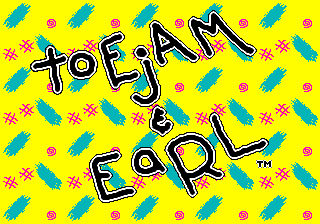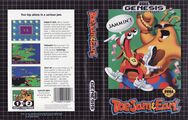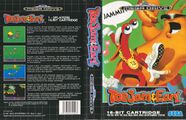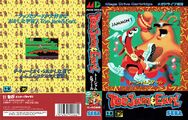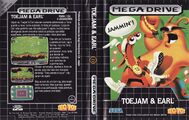Difference between revisions of "ToeJam & Earl"
From Sega Retro
m (spelling/grammar/fixes, typos fixed: extra-terrestrial → extraterrestrial) |
Scarred Sun (talk | contribs) |
||
| Line 46: | Line 46: | ||
==Physical Scans== | ==Physical Scans== | ||
{{ratings | {{ratings | ||
| + | | icon=MD | ||
| hobbyconsolas=87 | | hobbyconsolas=87 | ||
| mm=87 | | mm=87 | ||
| playerone=75 | | playerone=75 | ||
| − | | ace=20 {{num|53}} | + | | ace=20 |
| + | | ace_source={{num|53}} | ||
}}{{Scanbox | }}{{Scanbox | ||
| console=Mega Drive | | console=Mega Drive | ||
Revision as of 20:21, 17 March 2012
| ToeJam & Earl |
|---|
| System(s): Sega Mega Drive, Virtual Console |
| Publisher: Sega |
| Developer: Johnson Voorsanger Productions |
| Genre: Action |
ToeJam & Earl (トージャム&アール) is an action game developed by Johnson Voorsanger Productions, and published by Sega for the Sega Mega Drive. It stars two extraterrestrial rappers who, by way of pilot error, end up crash-landing on Earth. While there, they must search for the missing pieces of their spacecraft in hopes of reassembling it. The game frequently parodies and satirizes 1990s urban culture, and includes common 90's slang and a funk soundtrack. Much of this charm is what drew people toward the game. The game was followed by Toejam & Earl in Panic on Funkotron.
Gameplay
The game takes place in a surreal isometric world representing Earth, where land is in the form of a stack of randomly-generated floating islands. In each of the game's 25 island, the player must find the elevator that will bring them to the next level. Occasionally, a rocketship piece will be hidden somewhere on an island, although the player is not required to collect it right away before moving onto the next island. Every island besides the first is surrounded by a void, falling in at any time will cause the player to fall to the previous level.
Presents are scattered around the island that can be collected and used at any time. The effects of each present box are randomized each time the game is played. Some presents have helpful effects, such as restoring health, temporarily bestowing special abilities, or revealing hidden sections of the map. Others, however, can do more harm, and can do things such as summon enemies, cause the character to fall asleep and leave them open to attack, or randomize the effects of all the presents.
While most inhabitants of Earth will attack or otherwise hinder Toejam & Earl when they spot them, some will help them in exchange for money. The man in the carrot suit will identify presents, and the wizard will fully restore a character's health. On occasion, Santa Claus can be found, if the player is successful in sneaking up to him without alerting him, he will drop a few random presents.
The player has a rank shown on the bottom of the screen with their health and number of extra lives, and begins the game at the rank of 'Weiner'. As the player scores points by uncovering squares of the map and opening presents, their rank will increase at certain point values. When the player increases in rank, their maximum health increases, and for every second increase in rank, the player receives an extra life. The player is able to increase in rank eight times.
The game can either be played with one or two players. In two-player mode, if Toejam & Earl wander too far apart, the game will go into a split-screen so both players can keep track of their characters, with the screen returning to normal once the characters reunite. If Toejam & Earl walk into each other, they will high-five, causing the player with the most health to give a little to the player with less health. If one player loses all of their lives, they can also take a life from the other player to come back into the game.
The game ends when the player finds all 10 pieces of the spacecraft.
![]() sneaks and causes a character to use a present's special ability, when applicable.
sneaks and causes a character to use a present's special ability, when applicable. ![]() pulls up an item screen.
pulls up an item screen. ![]() switches to a map of the current island.
switches to a map of the current island.
Production Credits
Game Design: Greg Johnson
Game Program: Mark Voorsanger
Additional Programming: Robert Leyland
Music Direction: Mark Miller
Music Composition: John Baker
Artwork: Greg Johnson, Avril Harrison
Sound Fx: Robert Leyland, Mark Miller
Invaluable Aid: Paul Reiche, Fred Ford
Producer: Scott Berfield
Awesome Support: Hugh Bowen
Physical Scans
| 79 | |
|---|---|
| Based on 36 reviews | |
- ↑ 1700 igr dlya Sega, "" (RU; 2001-xx-xx), page 246
- ↑ ACE, "February 1992" (UK; 1992-01-08), page 98
- ↑ Beep! MegaDrive, "April 1992" (JP; 1992-03-07), page 35
- ↑ Computer Game Review, "January, 1992" (US; 199x-xx-xx), page 32
- ↑ Console XS, "June/July 1992" (UK; 1992-04-23), page 135
- ↑ Electronic Gaming Monthly, "November 1991" (US; 1991-1x-xx), page 24
- ↑ Entsiklopediya luchshikh igr Sega. Vypusk 1, "" (RU; 1999-xx-xx), page 363
- ↑ Mean Machines: The Essential Sega Guide, "" (UK; 1993-11-18), page 109
- ↑ Famitsu, "1992-03-20" (JP; 1992-03-06), page 38
- ↑ Game Power, "Febbraio 1992" (IT; 1992-0-xx), page 54
- ↑ GamePro, "October 1991" (US; 1991-xx-xx), page 40
- ↑ Gamers, "Februar/März 1992" (DE; 1992-xx-xx), page 60
- ↑ GamesMaster (UK) "Series 1, episode 5" (1992-02-04, 24:00) (+5:40)
- ↑ Games-X, "31st October-6th November 1991" (UK; 1991-10-31), page 36
- ↑ Game Informer, "November/December 1991" (US; 1991-xx-xx), page 33
- ↑ Game Zone, "January 1992" (UK; 1991-12-18), page 24
- ↑ Hippon Super, "April 1992" (JP; 1992-03-04), page 84
- ↑ Hobby Consolas, "Enero 1992" (ES; 199x-xx-xx), page 34
- ↑ Joypad, "Octobre 1991" (FR; 1991-09-17), page 65
- ↑ Joystick, "Octobre 1991" (FR; 1991-xx-xx), page 164
- ↑ Sega Mega Drive Advanced Gaming, "January 1993" (UK; 199x-xx-xx), page 95
- ↑ Mega Drive Fan, "June 1992" (JP; 1992-05-08), page 83
- ↑ Mega, "June 1993" (UK; 1993-05-20), page 21
- ↑ Mega Force, "Septembre/Octobre 1991" (FR; 1991-09-13), page 86
- ↑ MegaTech, "Xmas 1991" (UK; 1991-12-06), page 81
- ↑ Mean Machines, "November 1991" (UK; 1991-10-29), page 106
- ↑ Mean Machines Sega, "October 1992" (UK; 1992-09-xx), page 142
- ↑ Player One, "Novembre 1991" (FR; 1991-xx-xx), page 60
- ↑ Play Time, "3/92" (DE; 1992-02-05), page 86
- ↑ Sega Power, "February 1992" (UK; 1992-01-02), page 35
- ↑ Sega Pro, "November 1991" (UK; 1991-xx-xx), page 62
- ↑ Sega Pro, "April 1993" (UK; 1993-03-11), page 68
- ↑ Sega Force, "January 1992" (UK; 1991-12-12), page 30
- ↑ Sega Saturn Magazine, "September 1995" (JP; 1995-08-08), page 86
- ↑ Tricks 16 bit, "Tricks Sega Gold 800 igr" (RU; 1998-03-20), page 203
- ↑ Video Games, "4/91" (DE; 1991-12-06), page 32
